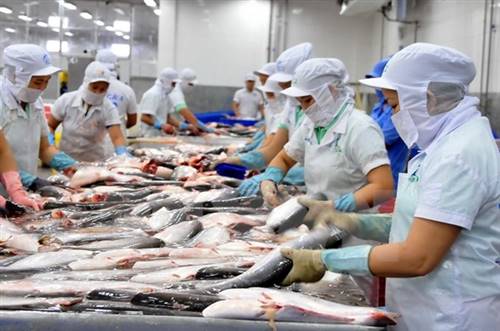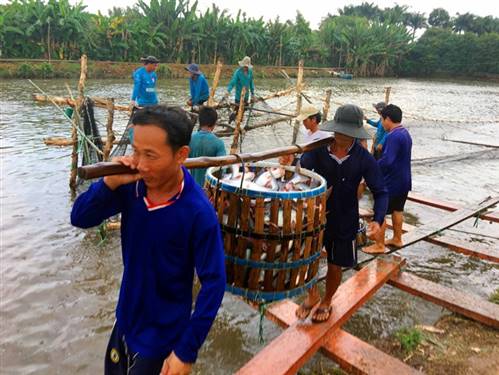Pangasius raw material prices reach highest-ever levels
Posted on 8/4/2018 12:00:00 AM by
One trader based in Vietnam told Undercurrent News prices were “crazy at this time; raw fish peaked at VND 32,000 ($1.40) [per kilogram], the highest price ever”.
A second source, an executive with a major processor and exporter, said they had seen offers to the farm of VND 37,000/kg.
Both confirmed prices remained firm due to a combination of high Chinese demand, and a scarcity of raw material, caused in turn by a lack of fingerlings available for farming.
“Priority is being given [by packers] to existing contracts and customers; packers are having to cherry-pick their customers,” said the executive.
“The prices of finished goods are firm and slightly up too. I expect this to continue, as the forward order book is full for the next nine months and supply in the ponds is known until year end.”
This source put prices to the EU, standard glazing, freight-on-board from Ho Chi Minh City now at between $3.20/kg and $3.25/kg. This was confirmed by a Dutch importer.
On top of this, premium fillet products are going for at least $1/kg more; one source estimated $4.25/kg, while the Dutch importer said $4.30-$4.50/kg.
Don Kelley, vice president of US importer Western Edge Seafood, told Undercurrent prices there continue to climb, “and are now in the high two-dollar range [per pound]”. Inventories in the US are very low, he added.
In January, US prices had been quoted as $2.20-$2.40 per pound, depending on moisture.
China continues to be an ideal market for Vietnamese producers; buyers are taking larger fish than EU customers tend to prefer, making life easier for Vietnam's value chain.
“They don't require certifications, but they still want a premium product. And they're paying the global prices,” the processing exec noted.
A nudge down in demand had been expected after the Chinese New Year holiday (Feb. 16), though this turns out not have been the case.
“There was a slight bump in trade, but that only really came as February was a short month, not because of a quiet period after the holiday. Prices didn't dip at all.”
As Undercurrent recently reported, Vietnamese pangasius prices to China are up more than 30% year-on-year. Current price firmness is still expected to run until early 2019, “barring any unforeseen circumstances”.
The executive with a Vietnamese packer acknowledged there was likely a price “ceiling” in terms of what buyers would accept. “We're already seeing some products, traditionally made from pangasius, being offered with Alaska pollock instead,” he said.
“But prices there might be on the way up now anyway. I think pangasius is getting the prices the industry deserves now, for all its work on traceability, certifications and marketing.”
He added that, as well as China, Japan and South Korea are beginning to look to pangasius as well. He credited Vinh Hoan Corporation with developing Japanese market.
US backlog
Speaking at Seafood Expo North America recently, Kelley told Undercurrent US pangasius importers have a backlog of orders with Vietnamese packers.
"Delays continue. And I'm not sure when they will abate, because what I'm hearing from packers is that there's still a backlog to address," he said. He estimated prices had risen by 18% in the 90 days prior to the Boston show.
The root of the problem, he said, is Vietnamese packers are being more cautious sending shipments to the US, now import inspection rules fall under the remit of the US Department of Agriculture (USDA), not the Food and Drug Administration (FDA).
"The packers have learned that having a refusal with USDA is a very expensive proposition, even compared to the FDA," said Kelley, whose firm imports both Vietnamese pangasius and Chinese tilapia. "With the FDA, you could make a mistake and correct course, fairly quickly. With the USDA, that's no longer the case."
By Neil Ramsden
Source: www.undercurrentnews.com
/PANGASIUS%20CUBES-%20WELL%20TRIMMED%20-1.jpeg?mode=crop&anchor=auto&scale=both&scache=true)
/catralamdau-2.jpg?mode=crop&anchor=auto&scale=both&scache=true)
/Pangasius%20Fillet%20Untrimmed-5.jpg?mode=crop&anchor=auto&scale=both&scache=true)
/carophi-1.jpg?mode=crop&anchor=auto&scale=both&scache=true)
/PANGASIUS%20STEAK%20-4.jpeg?mode=crop&anchor=auto&scale=both&scache=true)
/Pangasius%20Butterfly-%20Headless).jpg?mode=crop&anchor=auto&scale=both&scache=true)



